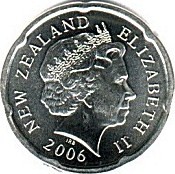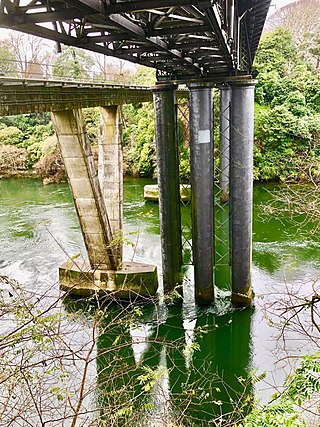
The New Zealand dollar is the official currency and legal tender of New Zealand, the Cook Islands, Niue, the Ross Dependency, Tokelau, and a British territory, the Pitcairn Islands. Within New Zealand, it is almost always abbreviated with the dollar sign ($). The abbreviations "$NZ" or "NZ$" are used when necessary to distinguish it from other dollar-denominated currencies.
The Reserve Bank of New Zealand (RBNZ) is the central bank of New Zealand. It was established in 1934 and is currently constituted under the Reserve Bank of New Zealand Act 2021. The governor of the Reserve Bank, currently Adrian Orr, is responsible for New Zealand's currency and operating monetary policy.

ANZ Bank New Zealand Limited is a New Zealand banking and financial services company, which operates as a subsidiary of Australia and New Zealand Banking Group Limited of Australia. ANZ is one of New Zealand's big four banks, and is the largest bank in New Zealand with approximately 30% of market share as of March 2021.
ISO 20022 is an ISO standard for electronic data interchange between financial institutions. It describes a metadata repository containing descriptions of messages and business processes, and a maintenance process for the repository content. The standard covers financial information transferred between financial institutions that includes payment transactions, securities trading and settlement information, credit and debit card transactions and other financial information.

The Beehive is the common name for the Executive Wing of New Zealand Parliament Buildings, located at the corner of Molesworth Street and Lambton Quay, Wellington. It is so-called because its shape is reminiscent of that of a traditional woven form of beehive known as a skep. It is registered as a Category I heritage building by Heritage New Zealand.

Trust Bank New Zealand Ltd was a registered bank that operated in New Zealand between 1986 and 1996. It was made up of the former regional savings banks that had their origins as far back as 1847. It was acquired by Westpac Bank in 1996 which phased out the Trust Bank brand at the end of 2002, when the bank was rebranded from WestpacTrust to simply Westpac.

The pound was the currency of New Zealand from 1840 until 1967, when it was replaced by the New Zealand dollar. Like the pound sterling, it was subdivided into 20 shillings each of 12 pence.

The New Zealand twenty-cent coin is the second-lowest-denomination coin of the New Zealand dollar. The 20-cent coin was introduced when the New Zealand dollar was introduced on 10 July 1967, replacing the New Zealand florin coin. Its original reverse of a kiwi was changed in 1990 when the image was moved onto the one-dollar coin. In 2006 its size was reduced and its edge altered to a Spanish flower as part of a revision of New Zealand's coins, which also saw its alloy become nickel-plated steel instead of cupro-nickel.
Sir Gilbert Simpson is a New Zealand businessman and computer programmer.
Ngāti Whakaue is a Māori iwi, of the Te Arawa confederation of New Zealand, tracing its descent from Whakaue Kaipapa, son of Uenuku-kopakō, and grandson of Tūhourangi. The tribe lives in the Rotorua district and descends from the Arawa waka. The Ngāti Whakaue village Ōhinemutu is within the township of Rotorua. The Ngāti Whakaue chief Pūkākī is depicted on the New Zealand 20 cent coin.
New Zealand dollar banknotes are the banknotes in circulation in New Zealand, the Cook Islands, Tokelau, Niue and the Pitcairn Islands, denominated in the New Zealand dollar. They are issued by the Reserve Bank of New Zealand and since 1999 have been made of polymer.

The New Zealand one-dollar coin ($1) is a coin of the New Zealand dollar. The current circulating coin was introduced on 11 February 1991 to replace the existing $1 note. There had previously been occasional issues of commemorative "silver dollars", but they are rarely seen in circulation.
The New Zealand two-dollar coin is the largest-denomination coin of the New Zealand dollar. It was introduced along with the one-dollar coin in 1990. Both are made from an alloy of aluminium and brass. It is the largest and heaviest coin in circulation, weighing ten grams and measuring 26.5 millimetres in diameter. Its thickness is 2.7 mm, only 0.4 mm thinner than the one-dollar coin, thus it is the second-thickest coin in the country's circulation. Both the $1 and $2 coins are gold-coloured, and requests for a Koha, donation or entry fee sometimes say gold coin please.
The New Zealand ten-cent coin is the lowest-denomination coin of the New Zealand dollar. The 10-cent coin was introduced when the New Zealand dollar was introduced on 10 July 1967, replacing the New Zealand shilling coin. In 2006 its size was reduced as part of a revision of New Zealand's coins, which also saw its alloy become copper-plated steel.

Graeme Paul Wheeler is a former Governor of the Reserve Bank of New Zealand from 2012 to September 2017. He succeeded Alan Bollard in this role on 26 September 2012 and was succeeded by Grant Spencer.
State Highway 22 (SH 22) is a New Zealand state highway just south of Auckland. It connects the town of Pukekohe to the Auckland Southern Motorway.

Claudelands Bridge is a dual-lane truss road bridge over the Waikato River, joining Claudelands with Hamilton Central. In 1968 it was converted from the old railway bridge, which had been completed about the end of July 1883. The road bridge was given a Category 2 listing in 1985.
The property bubble in New Zealand is a major national economic and social issue. Since the early 1990s, house prices in New Zealand have risen considerably faster than incomes, putting increasing pressure on public housing providers as fewer households have access to housing on the private market. The property bubble has produced significant impacts on inequality in New Zealand, which now has one of the highest homelessness rate in the OECD and a record-high waiting list for public housing. Government policies have attempted to address the crisis since 2013, but have produced limited impacts to reduce prices or increase the supply of affordable housing. However, prices started falling in 2022 in response to tightening of mortgage availability and supply increasing. Some areas saw drops as high as around 9% - albeit from very high prices.
Hopuhopu was a former New Zealand Army Camp in use from 1920 to 1989 and was located is 5 km (3.1 mi) north of the town of Ngāruawāhia.
Kerrin Margaret Vautier,, is a New Zealand economist. She is the deputy chair of the Reserve Bank of New Zealand.





















